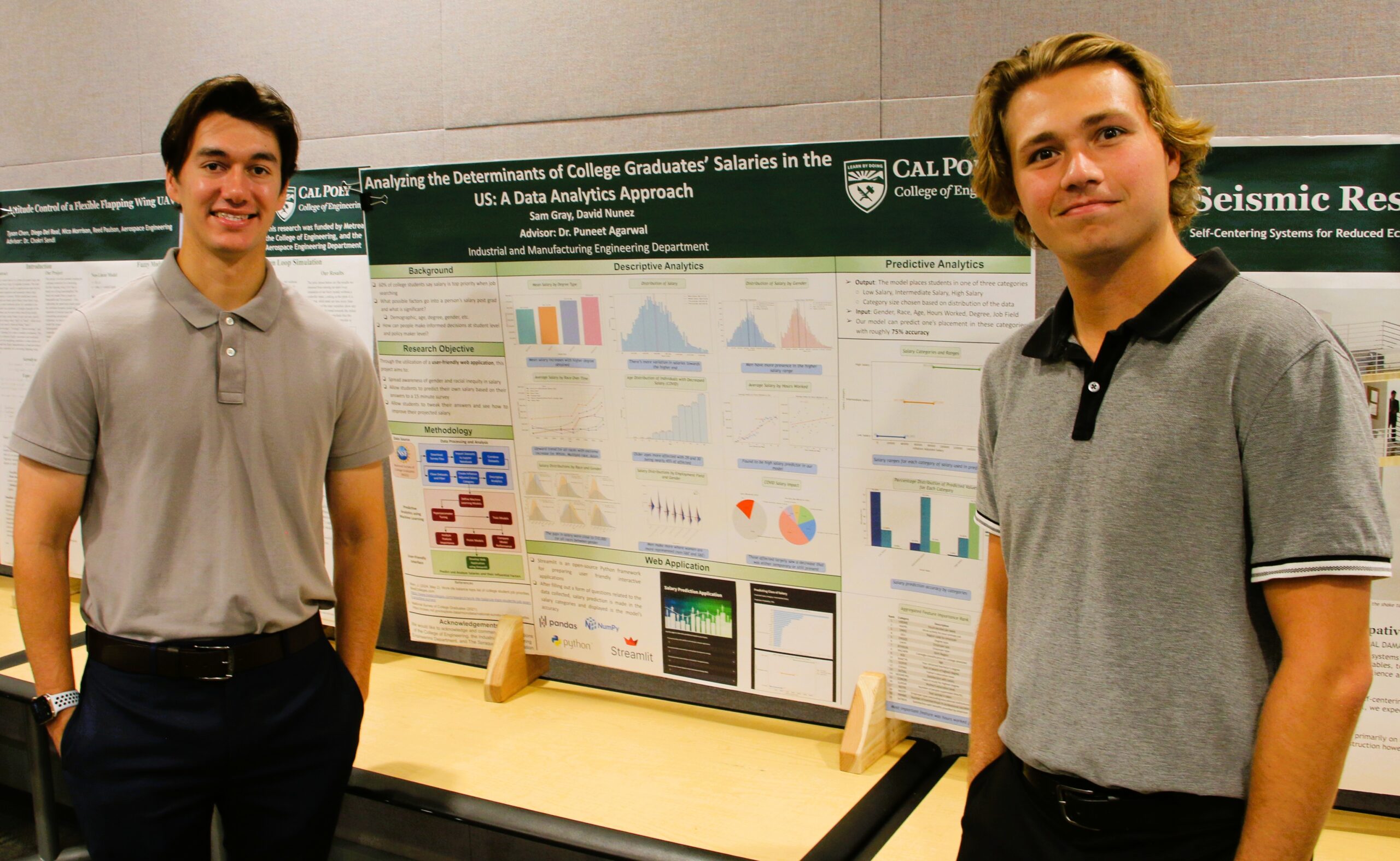
In the College of Engineering, students and faculty are using data science to develop groundbreaking tools and tackle real-world challenges. Through the ongoing series, “Data for Good: Innovators in Action,” we highlight how these efforts are driving meaningful change across various societal issues. Join us in exploring these stories and discover how you can be a part of the movement to create a brighter, more equitable world.
Industrial engineering seniors Samuel Gray and David Nunez are on a mission to answer a question that’s on every college student’s mind: How can I maximize my future salary?
Sparked by chats with friends about landing lucrative jobs, Gray and Nunez set out to explore what truly drives earnings. Guided by Professor Puneet Agarwal, they embarked on a summer research project to uncover the key factors that shape paychecks, aiming to give their fellow students an edge.
“Our study will offer valuable insights to help individuals shape their career paths and empower advocates for workplace equality in their fight for fairness,” Agarwal said.
Their research delves into how demographic and educational factors influence income. By analyzing data across states and over time, they pinpointed the main drivers of wage gaps and developed a prototype dashboard to help people make smarter decisions.
With their findings, the team can now predict a college graduate’s future salary with 72% accuracy — laying the groundwork for a tool that could reshape how people plan their careers and make workplaces fairer.

Decoding Salary Patterns
Agarwal vividly recalls researching salary potential during his college years in India, an experience that motivated him to help others as he began teaching data science.
Seeing the value and accessibility of the National Survey of College Graduates (NSCG) data, Agarwal made it the foundation of his research. The survey, conducted every two years by the Census Bureau with backing from the National Science Foundation, has been collecting detailed information on college graduates since 1993.
“With such a large dataset at our disposal, we knew we could extract meaningful insights on factors like gender, race and even the impacts of COVID,” Agarwal said.
Gray and Nunez eagerly joined the project through the Summer Undergraduate Research Program, seizing the opportunity to work alongside their professor. “I was excited to dive into a project that involves big data and databases,” said Nunez, who grew up in Santa Maria.
If they were hoping for a wealth of data, they certainly got it. The dataset was dense and complex, and just cleaning the data turned into a time-consuming process. Undeterred, the team filtered the data to focus on individuals under 30, including only those with bachelor’s or master’s degrees who are U.S. citizens. The NCSG collected data through three methods: an online survey, a mail questionnaire and telephone interviews.
The team sorted 350 different majors into eight groups, including engineers, computer scientists and nonscience fields. They focused on exploring how race, education and gender impact salaries, as well as differences in areas of study, the highest degree earned and the effects of COVID.
“The big idea was to write code that could analyze the data, identify key features and then use those features to create an algorithm capable of predicting salary,” said Gray, originally from Chicago.
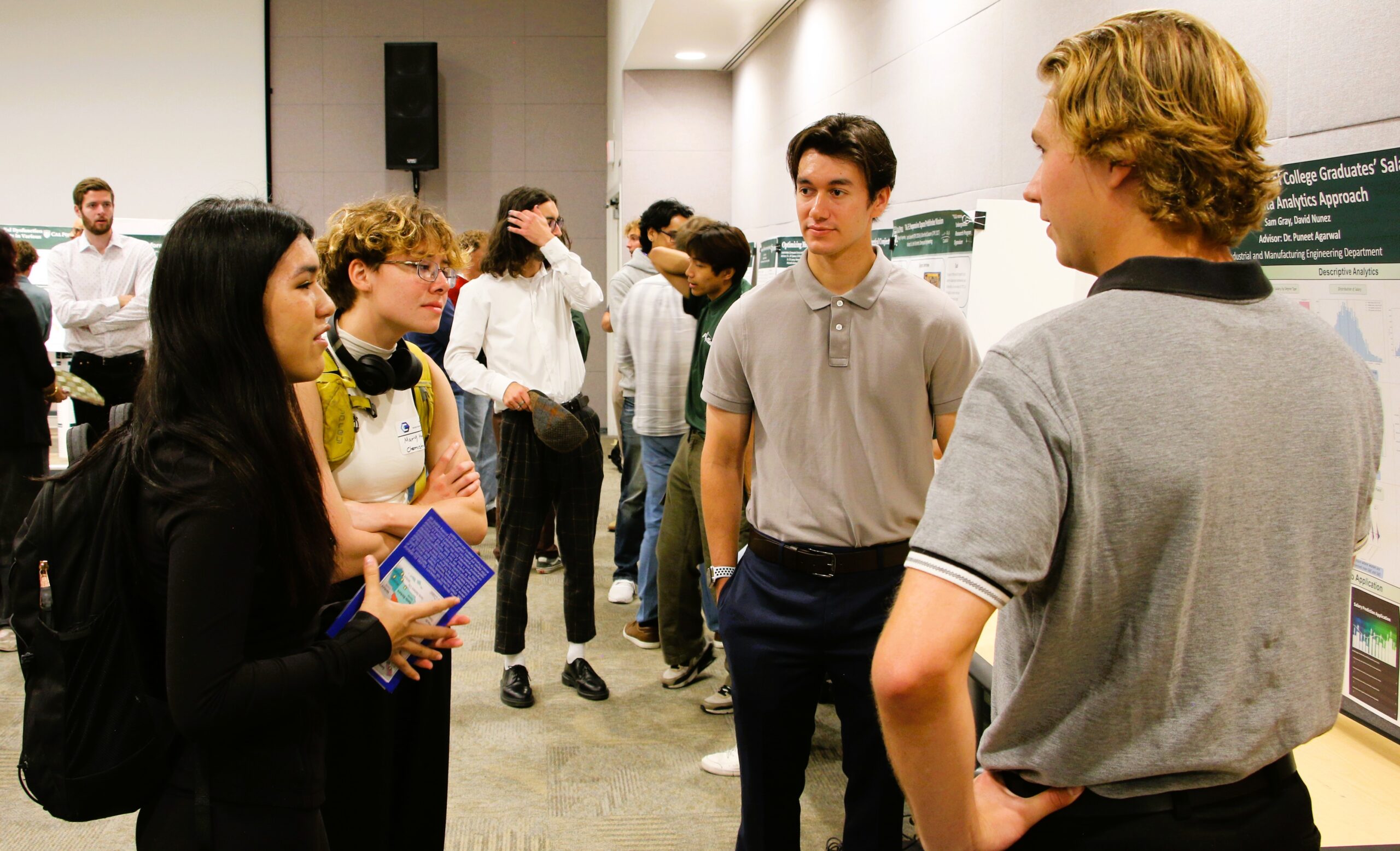
Key Discoveries
The research uncovered several revelations: higher degrees are generally linked to higher salaries, but wage gaps persist between men and women, as well as across different racial groups. Additionally, those over 20 were particularly impacted by the economic effects of COVID-19.
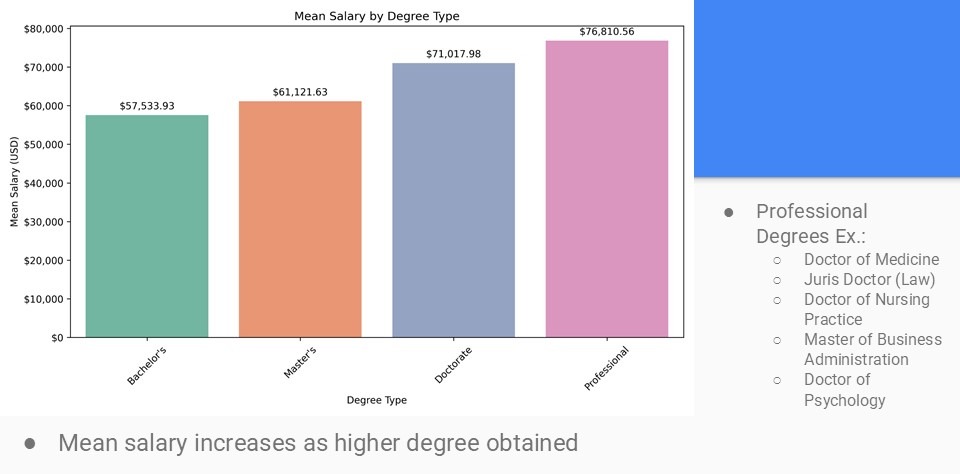
Impact of Education
Average salaries increased with higher levels of education, starting at $57,000 for a bachelor’s degree, rising to $61,000 for a master’s, $71,000 for a doctorate and nearly $77,000 for professional degrees like medicine or law. Other factors that connect to higher salaries include job satisfaction and hours worked per week, with strong gains up to 60 hours — after that, the connection weakens.
Gray shared a personal experience to illustrate this: “Last summer, I was waiting tables at a restaurant, working 60-70 hours a week but only across four days. This experience highlights why there’s a gap — many demanding jobs require long hours, but while some pay very well, others don’t.”
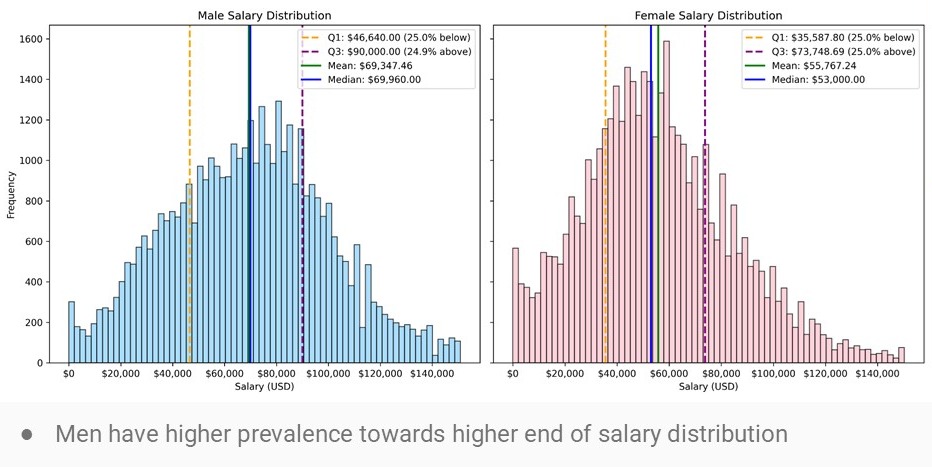
Persistent Wage Gaps
Men continue to earn significantly more than women with an average gap of about $15,000. Among top earners, men make $90,000 compared to $74,000 for women — a $16,000 difference. This disparity remains consistent across various fields.
“I expected the wage gap to have narrowed more, but it’s barely changed over the years,” Nunez said.
Men hold most positions in engineering and computer science fields, while nearly 50% of women with bachelor’s and master’s degrees are employed in nonscience roles.
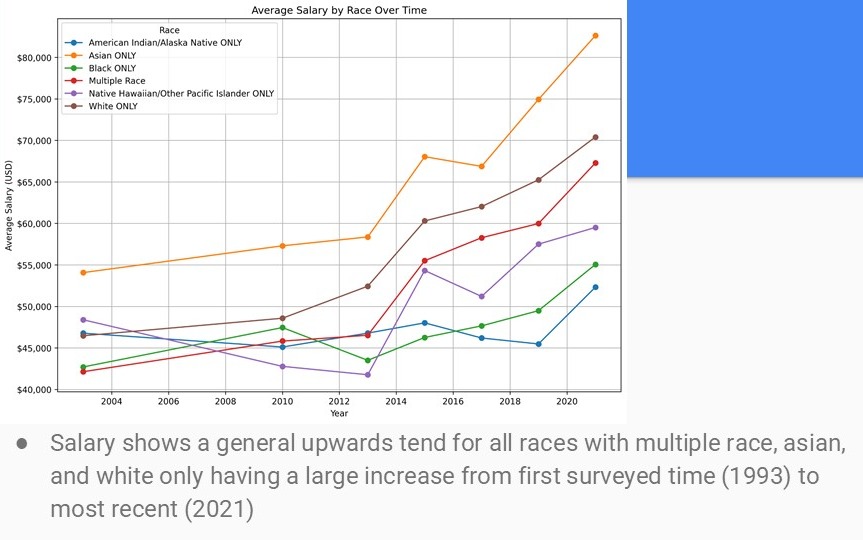
Racial Disparities
While the survey’s majority-White respondent pool could influence certain results, it still offers valuable insights into wage trends across racial groups. The pay gaps remained considerable, averaging close to $10,000. The largest wage gap appeared in the White category, where women’s salaries clustered closer to the median, while men’s earnings were more varied, indicating a notable gender disparity within this group.
However, when comparing across racial groups, broader disparities emerge. Asian and White respondents had more concentrated salary distributions, with earnings peaking around the average, while Black, Native Hawaiian and American Indian respondents had the lowest median salaries, underscoring substantial racial inequalities.
Nunez pointed out an area for improvement in surveys: “When I’ve filled out surveys, there often isn’t a clear choice for ethnicity. Some ask about my mother’s ethnicity — in my case, she’s White — but I’m Hispanic.”
COVID’s Impact
The majority of those affected by COVID-related salary changes were over 26 years old, with the most significant impacts on individuals aged 29 and 30 — the upper age limit of the survey. In the 2021 dataset, 18% of respondents reported that their salary was affected by COVID.
“In our data, we only looked at those 30 or younger, so it’s likely that those over 30 were even more affected by COVID. If we had included them, we might have seen more negative results,” Agarwal said.
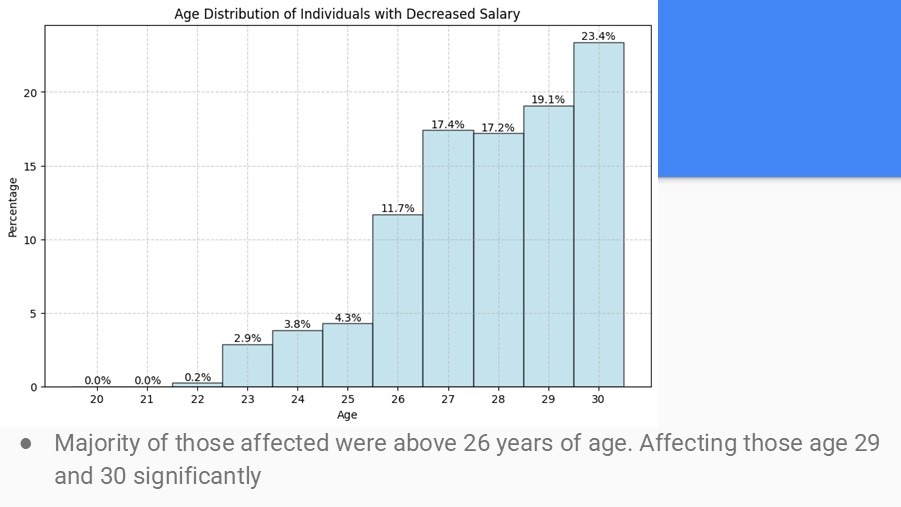
Algorithm in Action
Building on their findings, the team developed a prototype of an interactive dashboard that allows users to explore key salary factors — like hours worked, age and degree completion — to predict potential earnings.
“Students can input their details to see how high their salary could be,” Gray explained, emphasizing the tool’s ability to help identify steps for boosting future earnings.
While some factors are fixed, others — like choosing a different major or gaining more experience – offer clear pathways to improving prospects.
Initially, the model’s accuracy was just 10%, but with continuous improvements, it reached 72% and even greater accuracy is expected by the project’s end.
“It’s been a long process of fine-tuning, but seeing it perform so well has been incredibly rewarding,” said Nunez, who plans to focus on making it more user-friendly in the fall.
Agarwal views this project not just as a tool for student planning but as a spark for societal change. He hopes the data will drive workplace equality and influence salary decisions across industries, leading to fairer pay. Recognizing its potential, Agarwal is considering securing a patent to amplify the impact of their work.
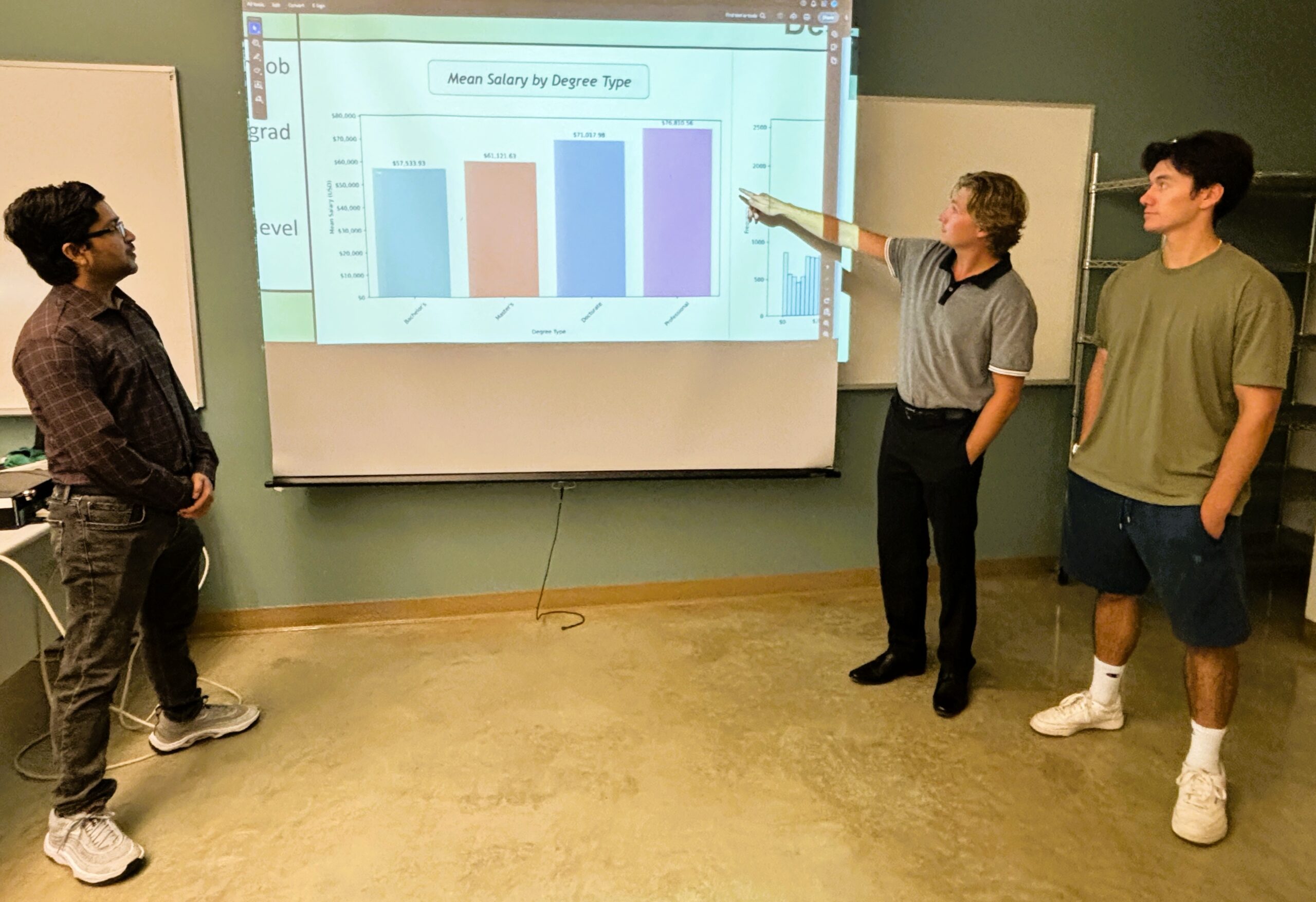
Call to Action: Be the Catalyst for Change!
Empower yourself and others with the insights from this story. Share this knowledge with your peers, colleagues and social networks to raise awareness about the critical factors shaping career success and workplace equality. Your voice can ignite meaningful conversations and drive real change.
Let’s make a difference together — start the conversation now!
By Emily Slater

